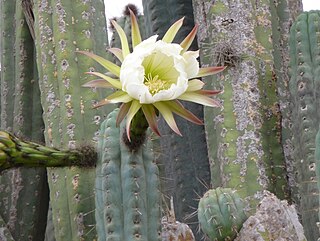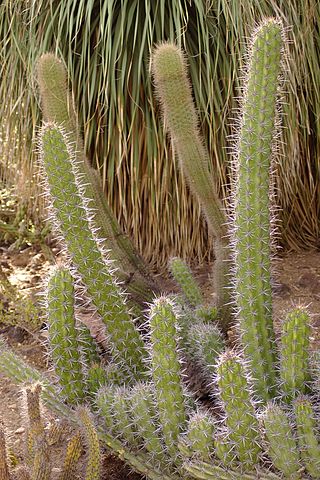
Echinocereus is a genus of ribbed, usually small to medium-sized, cylindrical shaped cacti, comprising about 70 species native to the southern United States and Mexico in very sunny, rocky places. Usually the flowers are large and the fruit edible.

Bergerocactus emoryi is a species of cactus, known commonly as the golden-spined cereus, golden snake cactus, velvet cactus or golden club cactus. It is a relatively small cactus, but it can form dense thickets or colonies, with the dense yellow spines giving off a velvety appearance when backlit by the sun. From April to May, yellow, green-tinged flowers emerge, which transform into reddish, globular fruit. This species is native to the California Floristic Province, and is found in northwestern Baja California and a small part of California, in San Diego County and on the southern Channel Islands. Where the Mediterranean climate of the California Floristic Province collides with the subtropical Sonoran Desert near El Rosario, hybrids with two other species of cacti are found. It is the sole member of the monotypic genus Bergerocactus, named after German botanist Alwin Berger.

Weberocereus is genus of cacti. It produces a green and white flower and is found mainly in Costa Rica and Nicaragua.

Leptocereus is a genus of cacti that are native to the Greater Antilles. It has been placed in the tribe Leptocereeae or in a broadly defined Echinocereeae.

Weingartia is a genus in the family Cactaceae, with species native to Bolivia and Argentina. It was formerly included in Rebutia, but molecular phylogenetic evidence suggested that it was distinct from that genus. As of December 2024, it was treated as separate genus by Plants of the World Online, and recognized as an alternative generic name in the third edition of the CITES Cactaceae Checklist. It may also be treated as Rebutia subg. Weingartia.

Echinopsis lageniformis, synonyms including Echinopsis scopulicola and Trichocereus bridgesii, is a cactus native to Bolivia. It is known as the Bolivian torch cactus. Among the indigenous populations of Bolivia, it is sometimes called achuma or wachuma, although these names are also applied to related species such as Trichocereus macrogonus which are also used for their psychedelic effects.

Lophocereus marginatus is a species of plant in the family Cactaceae. It is sometimes called Mexican fencepost cactus.

Cylindropuntia echinocarpa is a species of cactus known by the common names silver cholla, golden cholla, and Wiggins' cholla. It was formerly named Opuntia echinocarpa.

Echinocereus viridiflorus is a species of cactus known by the common names nylon hedgehog cactus, green pitaya, and small-flowered hedgehog cactus. It is native to the central and south-central United States and northern Mexico, where it can be found in varied habitat types, including desert scrub, woodlands, dry grasslands, and short-grass prairie.

Echinocereus dasyacanthus is a member of the cactus family, Cactaceae. It is one of about 2000 total species belonging to this family. The cactus is commonly known as Texas rainbow cactus because of the subtle rings or bands of contrasting colors along the stem of the plant. Not all Texas rainbow cacti have the "rainbow" coloration on their stems. Another common name is spiny hedgehog cactus.

Echinocereus stramineus is a species of cactus, with stramineus meaning made of straw. There are various common names such as strawberry cactus, porcupine hedgehog cactus, straw-color hedgehog, and pitaya. The straw-colored spines distinguishes this particular plant from other Echinocereus. The aged spines may turn white in color and are very fragile.

Leucostele terscheckii, commonly known as the cardon grande cactus or Argentine saguaro, is a large cactus native to South America and popular in cultivation.

Ferocactus diguetii, commonly known as the giant barrel cactus, is the largest species of barrel cactus in the genus Ferocactus. It is an insular species endemic to several of Baja California Sur's southern islands in the Gulf of California. As the superlative giant of the barrel cacti, it reaches heights of up to 4 metres (13 ft) and diameters of 1 metre (3.3 ft) in the wild, a result of island gigantism. The species has red flowers that bloom from March to May. Although restricted in range, this species grows in protected habitat and lacks major threats.

Stenocereus gummosus is a flowering plant in the family Cactaceae that is found in Baja California, Mexico at elevations of 9 to 134 meters

Echinopsis strigosa, is a species of Soehrensia in the cactus family. It is native to north western Argentina. It was first published in Cactaceae Syst. Init. 28: 31 in 2012.

Echinocereus websterianus, commonly known as the San Pedro Nolasco hedgehog cactus or Webster's hedgehog cactus, is a species of cactus. It is named after American philanthropist Gertrude Webster, who cofounded the Desert Botanical Garden in Phoenix, Arizona.

Myrtillocactus cochal, the cochal or candelabra cactus, is a species of flowering plant in the family Cactaceae, native to the Baja California peninsula. Individuals can reach 3 m (10 ft), and are hardy to USDA zone 9b.

Echinocereus sciurus is a species of cactus native to Mexico.

Echinocereus pacificus is a species of cactus native to Mexico.

Echinocereus santaritensis is a species of cactus native to Mexico and the United States.





















